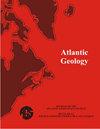加拿大新斯科舍Meguma地盆系Trafalgar岩体套的岩石学特征及与其他泥盆系花岗岩类岩体的比较
IF 0.9
4区 地球科学
Q2 GEOLOGY
引用次数: 1
摘要
Trafalgar Plutonic Suite侵入新斯科舍省南部Meguma地体东北部的Goldenville和Halifax群的变质沉积岩,时间约为374 Ma,基于先前公布的U–Pb和40Ar/39Ar矿物年龄。通过野外和岩相观察,根据粒度(细、中或粗)、质地(等粒或斑状)和模式矿物学(石英闪长岩/英云闪长岩、花岗闪长岩,二长花岗岩和正长花岗岩)的变化,将该岩组划分为20个不同的深成岩体。花岗闪长岩、二长花岗岩和正长花岗岩深成岩体的成分相对均匀,每个深成岩体内或相同岩性的深成岩体之间的矿物学或化学变化很小。相比之下,石英闪长岩/英云闪长岩深成岩体在深成岩体内部和之间表现出矿物学和化学变化。花岗闪长岩、二长花岗岩和正长花岗岩深成岩体与Meguma地体特征的其他过铝质花岗质深成岩体非常相似。石英闪长岩/英云闪长岩深成岩体多种多样,但在化学上类似于Meguma地体其他地方的小型泥盆纪镁铁质侵入体。与Meguma地体的其他深成岩体一样,Trafalgar Plutonic Suite具有火山弧到同碰撞花岗质岩石的化学特征,并且可能经历了变质沉积物质的广泛污染,正如之前对Meguma地体深成岩体的研究所记录的那样。次要的石英闪长岩/英云闪长岩深成岩体是镁铁质岩石的另一个例子,在Meguma地体的构造模型中提出,镁铁质岩石促进了下地壳的熔融,产生了花岗闪长质母岩浆,随后发生了晶体分馏和变质沉积物质的广泛污染。本文章由计算机程序翻译,如有差异,请以英文原文为准。
Field relations and petrology of the Trafalgar Plutonic Suite and comparisons with other Devonian granitoid plutons in the Meguma terrane, Nova Scotia, Canada
The Trafalgar Plutonic Suite intruded metasedimentary rocks of the Goldenville and Halifax groups in the northeastern part of the Meguma terrane of southern Nova Scotia at about 374 Ma, based on previously published U–Pb and 40Ar/39Ar mineral ages. Using field and petrographic observations, the suite is divided into 20 different plutons on the combined basis of variations in grain size (fine, medium, or coarse), texture (equigranular or porphyritic) and modal mineralogy (quartz diorite/tonalite, granodiorite, monzogranite, and syenogranite). The granodiorite, monzogranite, and syenogranite plutons are relatively uniform in composition with little variation in mineralogy or chemistry within each pluton or between plutons of the same lithology. In contrast the quartz diorite/tonalite plutons show mineralogical and chemical variation, both within and between plutons. The granodiorite, monzogranite, and syenogranite plutons closely resemble other peraluminous granitoid plutons characteristic of the Meguma terrane. The quartz diorite/tonalite plutons are varied but chemically resemble minor Devonian mafic intrusions elsewhere in the Meguma terrane. Like other plutons of the Meguma terrane, the Trafalgar Plutonic Suite has chemical characteristics of volcanic-arc to syn-collisional granitoid rocks and likely has experienced extensive contamination by metasedimentary material as documented by previous studies of plutons in the Meguma terrane. The minor quartz diorite/tonalite plutons are additional examples of the mafic rocks that have been proposed in tectonic models of the Meguma terrane to have facilitated melting of the lower crust to generate granodioritic parent magmas, followed by crystal fractionation and extensive contamination by metasedimentary material.
求助全文
通过发布文献求助,成功后即可免费获取论文全文。
去求助
来源期刊

Atlantic Geology
GEOLOGY-
CiteScore
2.10
自引率
18.80%
发文量
0
审稿时长
>12 weeks
期刊介绍:
Atlantic Geology (originally Maritime Sediments, subsequently Maritime Sediments and Atlantic Geology) covers all aspects of the geology of the North Atlantic region. It publishes papers, notes, and discussions on original research and review papers, where appropriate to the regional geology.
 求助内容:
求助内容: 应助结果提醒方式:
应助结果提醒方式:


